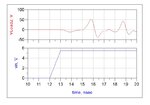f_t
Member level 4
Stability of PA by applying a step input
Friends,
I am evaluating the stability of my PA. K_factor ( stab_fact(S) ) and B1 (stab_meas(S)) are more than 1 and 0, respectively at all frequencies. So my PA should be stable.
I have done another test too. I have applied an step signal at input and seen output voltage. As it is clear in the figure it oscillates and is not stable!!! why?!!! I have used a transient analysis for step response.
Using step response is a mistake to evaluate stability or my circuit is not really stable?!
Could you help me?

Friends,
I am evaluating the stability of my PA. K_factor ( stab_fact(S) ) and B1 (stab_meas(S)) are more than 1 and 0, respectively at all frequencies. So my PA should be stable.
I have done another test too. I have applied an step signal at input and seen output voltage. As it is clear in the figure it oscillates and is not stable!!! why?!!! I have used a transient analysis for step response.
Using step response is a mistake to evaluate stability or my circuit is not really stable?!
Could you help me?

Last edited: